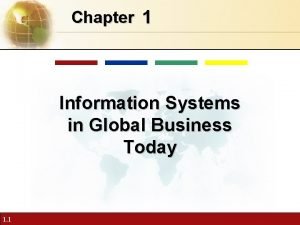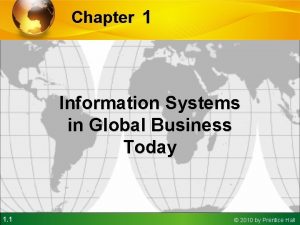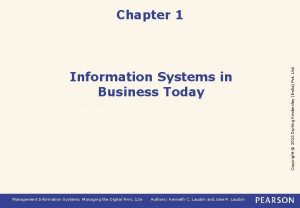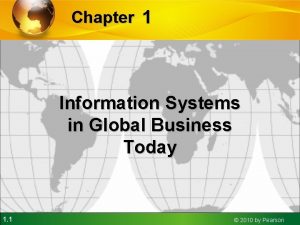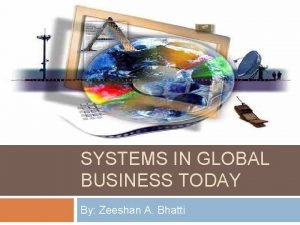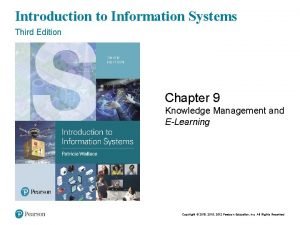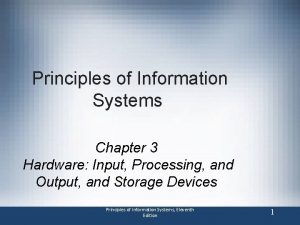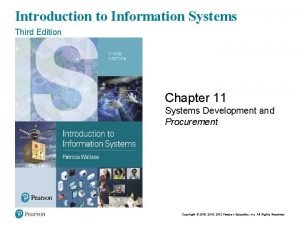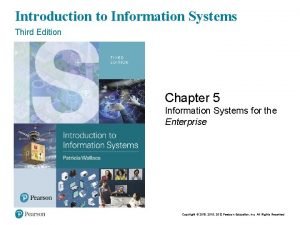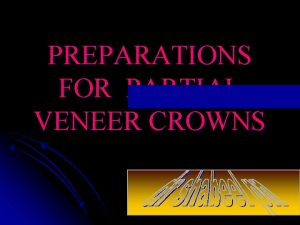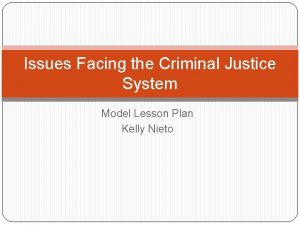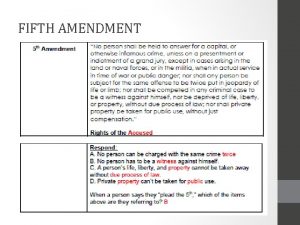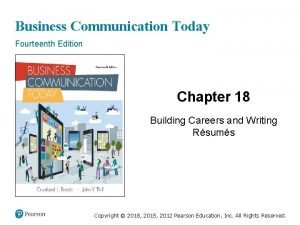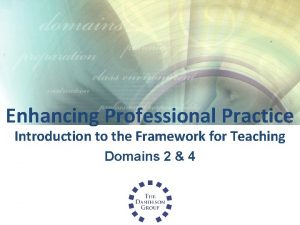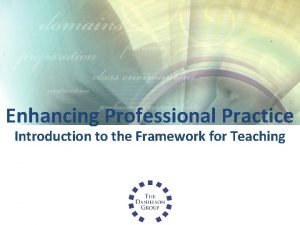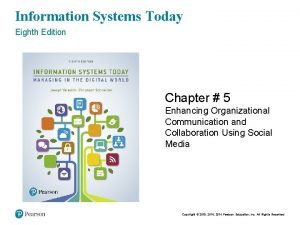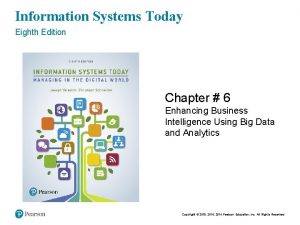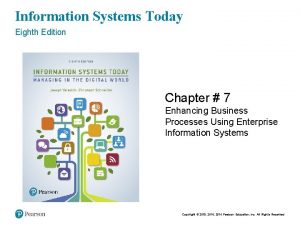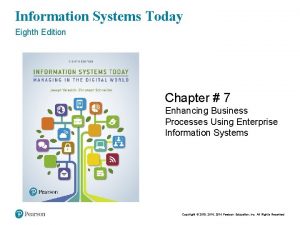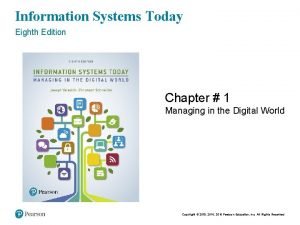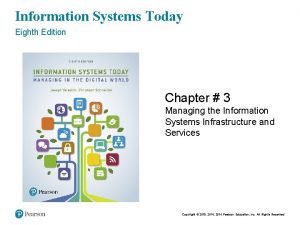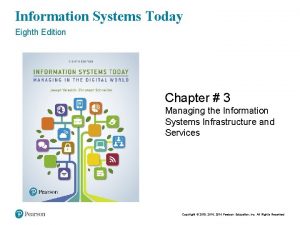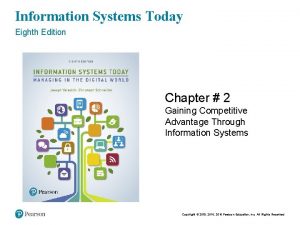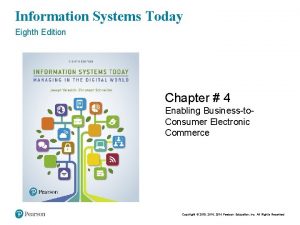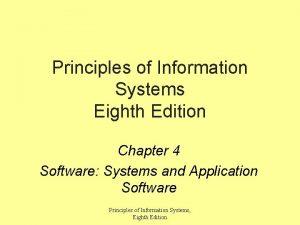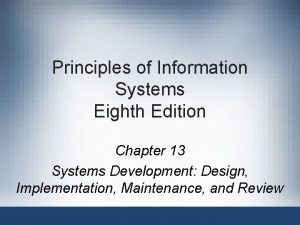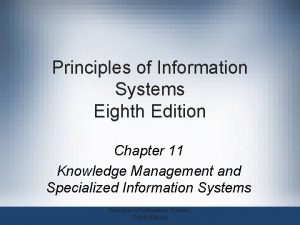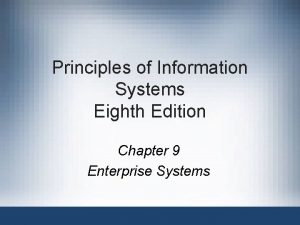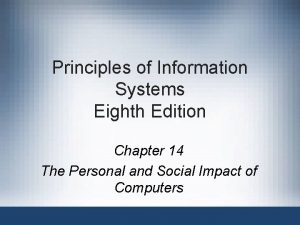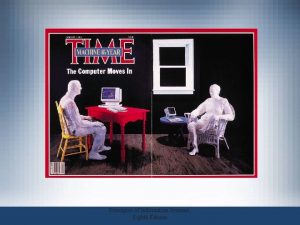Information Systems Today Eighth Edition Chapter 6 Enhancing













































- Slides: 45

Information Systems Today Eighth Edition Chapter # 6 Enhancing Business Intelligence Using Big Data and Analytics Copyright © 2018, 2016, 2014 Pearson Education, Inc. All Rights Reserved

Learning Objectives • • • 6. 1 Describe the need for business intelligence and advanced analytics and how databases serve as a foundation for making better business decisions. 6. 2 Explain core concepts of business intelligence and advanced analytics. 6. 3 Describe how organizations can enhance decision making by using knowledge management and geographic information systems. Copyright © 2018, 2016, 2014 Pearson Education, Inc. All Rights Reserved

Enhancing Organizational Decision Making • Learning Objective: Describe the need for business intelligence and advanced analytics and how databases serve as a foundation for making better business decisions. • Why Organizations Need Business Intelligence and Advanced Analytics • Databases: Providing Inputs into Business Intelligence and Advanced Analytics Copyright © 2018, 2016, 2014 Pearson Education, Inc. All Rights Reserved

Business Intelligence, Advanced Analytics, Business Analytics • Looking back and answering important questions require analyzing data of past and current transactions to understand what happened • Business Intelligence (BI) refers to tools and techniques for analyzing and visualizing past data • Advanced analytics refers to tools and techniques used to understand why something happened, predict future outcomes, or discover hidden patterns in large data sets • Business analytics is used as an umbrella term for all these concepts Copyright © 2018, 2016, 2014 Pearson Education, Inc. All Rights Reserved

Business Intelligence and Advanced Analytics (Table 6. 1) • The need for business intelligence and advanced analytics goes beyond traditional businesses; rather all types of organizations utilize it to improve their data-driven decision making as seen in the examples below Context Example Political parties Model the influence of social media on election outcomes Government Analyze performance of public benefits programs Defense Manage maintenance and logistics during overseas deployments Hospitals Predict patient volume and resource utilization Nonprofit organizations Manage fundraising campaigns and target donors Copyright © 2018, 2016, 2014 Pearson Education, Inc. All Rights Reserved

Responding to Threats and Opportunities Copyright © 2018, 2016, 2014 Pearson Education, Inc. All Rights Reserved

Big Data Copyright © 2018, 2016, 2014 Pearson Education, Inc. All Rights Reserved

Understanding Big Data • Businesses are dealing with the challenge of “Big Data” – High Volume § Unprecedented amounts of data – High Variety § Structured data § Unstructured data – High Velocity § Rapid processing to maximize value Copyright © 2018, 2016, 2014 Pearson Education, Inc. All Rights Reserved

Effective Planning is Continuous Copyright © 2018, 2016, 2014 Pearson Education, Inc. All Rights Reserved

Databases: Providing Inputs into Business Intelligence and Advanced Analytics • Data and knowledge are an organization’s most valuable resource • Enabling interactive Web sites using databases: – E-commerce makes extensive use of databases – Product catalog data are stored in databases and available to users – Customer billing and shipping – E-commerce applications process millions of transactions per day Copyright © 2018, 2016, 2014 Pearson Education, Inc. All Rights Reserved

Databases: Foundation Concepts Copyright © 2018, 2016, 2014 Pearson Education, Inc. All Rights Reserved

Databases: Tables and Records This sample data table for the entity Students includes 7 attributes and 10 records Source: Microsoft Access Copyright © 2018, 2016, 2014 Pearson Education, Inc. All Rights Reserved

Databases: Advantages (Table 6. 2) Advantages Description Minimal data redundancy There is a single copy of the data Improved data consistency Eliminating redundancy improves consistency Increase security Simplifies enforcement of access restrictions Improved data quality Centralized control, minimized redundancy, and improved data consistency enhance data quality Improved data accessibility and sharing A centralized system makes it easier to deploy and control access in or out of the organization Enforcement of standards Centralized data management standardizes rules Program-data independence Easier to evolve and alter software to changing business needs when independent Increased productivity of application development Data standards make it easier to build and modify applications Reduced program maintenance Changes in data replicate seamlessly Copyright © 2018, 2016, 2014 Pearson Education, Inc. All Rights Reserved

Databases: Effective Management • The Data Model – What data will be captured – How the data will be represented • The Data Dictionary – Document of database metadata § Attribute name § Type of data § Valid values § Business rules Copyright © 2018, 2016, 2014 Pearson Education, Inc. All Rights Reserved

Databases: Entering and Querying Data Copyright © 2018, 2016, 2014 Pearson Education, Inc. All Rights Reserved

Databases: Query via Graphical User Interface • Source: Courtesy of Microsoft Corporation Copyright © 2018, 2016, 2014 Pearson Education, Inc. All Rights Reserved

Online Transaction Processing • Online Transaction Processing (OLTP) – Systems that interact with customers and run a business in real time • Data Warehouses – Integrate data from multiple database and other data sources – Contain historic as well as current data • Data Marts – Subset of a data warehouse, limited in scope Copyright © 2018, 2016, 2014 Pearson Education, Inc. All Rights Reserved

Operational vs. Informational Systems (Table 6. 4) Characteristic Operational System Informational System Primary Purpose Run the business on a current basis Support managerial decision making Type of data Current representation of state of the business Historical or point-in-time (snapshot) Primary users Online customers, clerks, salespersons, administration Managers, business analysts, and customers (checking status and history) Scope of usage Narrow and simple updates and queries Broad and complex queries and analyses Design goal Performance Ease of access and use Copyright © 2018, 2016, 2014 Pearson Education, Inc. All Rights Reserved

Data Warehouses: Extract, Transform, Load Copyright © 2018, 2016, 2014 Pearson Education, Inc. All Rights Reserved

Business Intelligence and Advanced Analytics • Learning Objective: Explain core concepts of business intelligence and advanced analytics. • Business Intelligence • Advanced Analytics Copyright © 2018, 2016, 2014 Pearson Education, Inc. All Rights Reserved

Business Intelligence Tools • Decision Support Systems – Used to support decision making at all levels in the organization • Online Analytical Processing (OLAP) – Process of quickly conducting complex, multidimensional analyses of data stored that is optimized for retrieval usually using graphical software tools Copyright © 2018, 2016, 2014 Pearson Education, Inc. All Rights Reserved

OLAP Terms and Concepts • Measures – Facts, numerical data that can be aggregated • Dimensions – Provides a way to summarized the data – Hierarchically arranged to enable drill-down and roll-up • Cubes – Multidimensional structure of dimensions and measures • Slicing and Dicing – Analyzing data on a subset of dimensions Copyright © 2018, 2016, 2014 Pearson Education, Inc. All Rights Reserved

Online Analytical Processing • An OLAP cube is a multidimensional database structure to support slicing, dicing, and drill-down Copyright © 2018, 2016, 2014 Pearson Education, Inc. All Rights Reserved

Information Visualization (Digital Dashboards) • Digital dashboards are used to visually present key performance indicators used by management • Data usually highly aggregate • They use a variety of design elements to present data in a user friendly way Copyright © 2018, 2016, 2014 Pearson Education, Inc. All Rights Reserved

Visual Analytics • Visual analytics is the combination of various analysis techniques and interactive visualization to solve complex problems Copyright © 2018, 2016, 2014 Pearson Education, Inc. All Rights Reserved

Advanced Analytics • Advanced analytics are designed to help users gain a deeper understanding of why things happen and then build predictive models to support decision making • Data science describes the advanced analytics field of study and practice • Advanced analytics are often used by business analysts to take decisions out of their hands, thus freeing up valuable resources Copyright © 2018, 2016, 2014 Pearson Education, Inc. All Rights Reserved

Data Mining • Discovering “hidden” predictive relationships in the data • Complicated algorithms run on large data warehouses • Types of data mining algorithms – – Association discovery Clustering Classification Text and Web content mining Copyright © 2018, 2016, 2014 Pearson Education, Inc. All Rights Reserved

Text Mining • Web content mining refers to extracting textual information from Web documents afterwhich text mining is used to apply analytical techniques to produce useful reports Copyright © 2018, 2016, 2014 Pearson Education, Inc. All Rights Reserved

Data Mining Results • Data mining results can be delivered to users in a variety of ways Copyright © 2018, 2016, 2014 Pearson Education, Inc. All Rights Reserved

Machine Learning Copyright © 2018, 2016, 2014 Pearson Education, Inc. All Rights Reserved

Intelligent Systems • Artificial intelligence (AI) is the science of enabling information technologies to simulate human intelligence • Intelligent agent (also called a bot) is a program that works in the background to provide some service when a specific event occurs. – Examples include: § Apple’s Siri § Microsoft’s Cortana Copyright © 2018, 2016, 2014 Pearson Education, Inc. All Rights Reserved

Knowledge Management and Geographic Information Systems • Learning Objective: Describe how organizations can enhance decision making by using knowledge management and geographic information systems. • Knowledge Management Systems • Geographic Information Systems Copyright © 2018, 2016, 2014 Pearson Education, Inc. All Rights Reserved

Knowledge Management Systems • Explicit knowledge – Easily codified and documented • Tacit knowledge – Embedded in people’s minds – Hard to get at – Important for best practices Goal: gain the greatest value from knowledge assets Copyright © 2018, 2016, 2014 Pearson Education, Inc. All Rights Reserved

Social Network Analysis • Social network analysis is a technique that maps people’s contacts to discover connections or missing links within the organization Copyright © 2018, 2016, 2014 Pearson Education, Inc. All Rights Reserved

Geographic Information Systems • A geographic information system (GIS) is a system for creating, storing, analyzing, and managing geographically referenced information • GIS benefits greatly from advances in machine learning, especially for recognizing and classifying geographical features Copyright © 2018, 2016, 2014 Pearson Education, Inc. All Rights Reserved

END OF CHAPTER CONTENT Copyright © 2018, 2016, 2014 Pearson Education, Inc. All Rights Reserved

Managing in the Digital World: Intelligence through Drones • Commercial drones have a mind of their own – Can maintain stability in windy conditions – Can automatically return home when battery is low – Can communicate with each other • DARPA actively working on improving capabilities – Producing a new class of drones referred to as UAVs – Can navigate inside buildings without GPS or pilot • Amazon working to deliver packages by drones – Deliver within 30 minutes from local warehouses Copyright © 2018, 2016, 2014 Pearson Education, Inc. All Rights Reserved

Green IT: Big Data, Internet of Things, and Analytics Fuel Greener Facilities • Big Data and Io. T are transforming business and society • The Microsoft campus has over 100 buildings – Within those buildings are more than 30 K system components with over 2 million sensors – Within 24 hours they produce a billion data points which provides data for better facilities management • Big data generated through Io. T holds great promise for identifying cost savings and preventing equipment failures Copyright © 2018, 2016, 2014 Pearson Education, Inc. All Rights Reserved

When Things Go Wrong: Twitter Fever—Look Before You Tweet • Twitter allows very rapid dissemination and sharing of information • People often retweet something they find touching without verifying its accuracy first • The shortness of tweets also limits background and context, so information is easily distorted • Stories can gain rapid momentum regardless of truth or fact and have damaging consequences Copyright © 2018, 2016, 2014 Pearson Education, Inc. All Rights Reserved

Coming Attractions: Emotion Aware Gaming • Affectiva, a Boston tech firm, uses a web cam to capture a person’s facial expression • With this information, game designers are able to adjust the level of play • Affectiva has collected more than 40 billion data points for interpreting emotion from a person’s face • They hope to build other games with this data Copyright © 2018, 2016, 2014 Pearson Education, Inc. All Rights Reserved

Who’s Going Mobile: Identifying Malaria Hotspots • A Wi-Fi hotspot is a place of significance, a place where groups of people are located • Researchers can use these areas for study • Example: in rural Africa cell towers can follow people because government allows tracking of cell phones – People making calls or sending texts from a particular tower were more likely to be carriers of malaria • Allows researchers to better combat the disease Copyright © 2018, 2016, 2014 Pearson Education, Inc. All Rights Reserved

Ethical Dilemma: Orwellian Internet of Things • Orwellian, an adjective, based on George Orwell’s book when he wrote on a future tyrannical society • Wide range of Io. T devices where sensors can scoop up massive amounts of data • In 2016, the U. S. admitted it was using Io. T devices for spying and snooping on possible terrorists • In combination with advanced analytics, the Io. T allows companies to provide unprecedented services to customers. Copyright © 2018, 2016, 2014 Pearson Education, Inc. All Rights Reserved

Security Matters: Hacktivists Versus Fembots: The Ashley Madison Case • In 2015 a group of hacktivists broke into the Ashley Madison site (an extramarital dating site) • Gained access to massive amounts of data • Held the data ransom to force the site to shut down • Publicly released 32 million user names resulting in events such as suicide and public embarrassment • Analysis of the hacked data revealed a large portion were female chatbots (intelligent agents) thus the name Fembots Copyright © 2018, 2016, 2014 Pearson Education, Inc. All Rights Reserved

Industry Analysis: Healthcare • Health care providers and insurance companies are turning to information systems – – Electronic medical records and prescriptions Digital imaging systems Telemedicine Robotic surgery • Consumers are turning to Web sites for health information – Dedicated sites such as Web. MD – Social media postings related to a condition/symptoms Copyright © 2018, 2016, 2014 Pearson Education, Inc. All Rights Reserved

Copyright © 2018, 2016, 2014 Pearson Education, Inc. All Rights Reserved
 Psychology eighth edition david g myers
Psychology eighth edition david g myers Psychology
Psychology Operations management eighth edition
Operations management eighth edition Information systems in global business today
Information systems in global business today Information systems in global business today
Information systems in global business today Survival in information system
Survival in information system Information system in global business today
Information system in global business today Information system in global business today
Information system in global business today Information system in global business today
Information system in global business today Introduction to information systems 6th edition
Introduction to information systems 6th edition Fundamentals of information systems 9th edition
Fundamentals of information systems 9th edition Fundamentals of information systems 9th edition
Fundamentals of information systems 9th edition White-collar workers คือ
White-collar workers คือ Vertical
Vertical Introduction to information systems 3rd edition
Introduction to information systems 3rd edition Introduction to information systems 5th edition
Introduction to information systems 5th edition Principles of management information system
Principles of management information system Principles of information systems 11th edition
Principles of information systems 11th edition Fundamentals of information systems
Fundamentals of information systems Essentials of mis, 13th edition
Essentials of mis, 13th edition Introduction to information systems 3rd edition
Introduction to information systems 3rd edition Fundamentals of information systems 9th edition
Fundamentals of information systems 9th edition Introduction to information systems 3rd edition
Introduction to information systems 3rd edition Anagram of eighth
Anagram of eighth Eighth planet from the sun
Eighth planet from the sun Nearest eighth of an inch
Nearest eighth of an inch The fifth, sixth, seventh, and eighth amendments protect *
The fifth, sixth, seventh, and eighth amendments protect * 8th commandment catholic
8th commandment catholic Taj mahal 8th wonder of the world
Taj mahal 8th wonder of the world Half crown preparation
Half crown preparation Eighth amendment excessive bail
Eighth amendment excessive bail Eighth letter of the alphabet
Eighth letter of the alphabet Criminal justice lesson
Criminal justice lesson 8 amendment
8 amendment Today meeting or today's meeting
Today meeting or today's meeting Are you going to class today
Are you going to class today Today meeting or today's meeting
Today meeting or today's meeting Fingerprint galton details
Fingerprint galton details Today's lesson or today lesson
Today's lesson or today lesson Today's lesson or today lesson
Today's lesson or today lesson Business communication today 14th edition
Business communication today 14th edition Criminology today 7th edition
Criminology today 7th edition Four enhancing qualitative characteristics
Four enhancing qualitative characteristics Enhancing professional practice
Enhancing professional practice Charlotte danielson framework
Charlotte danielson framework Enhancing personal effectiveness
Enhancing personal effectiveness



